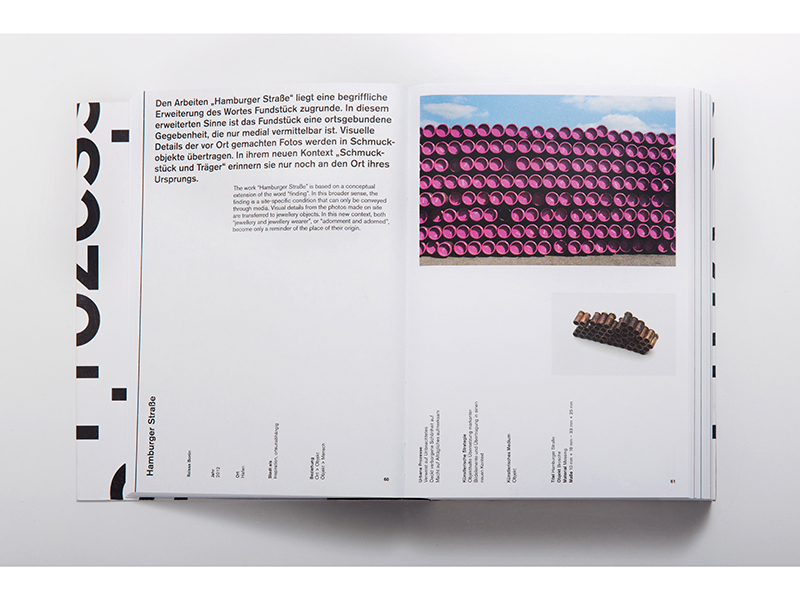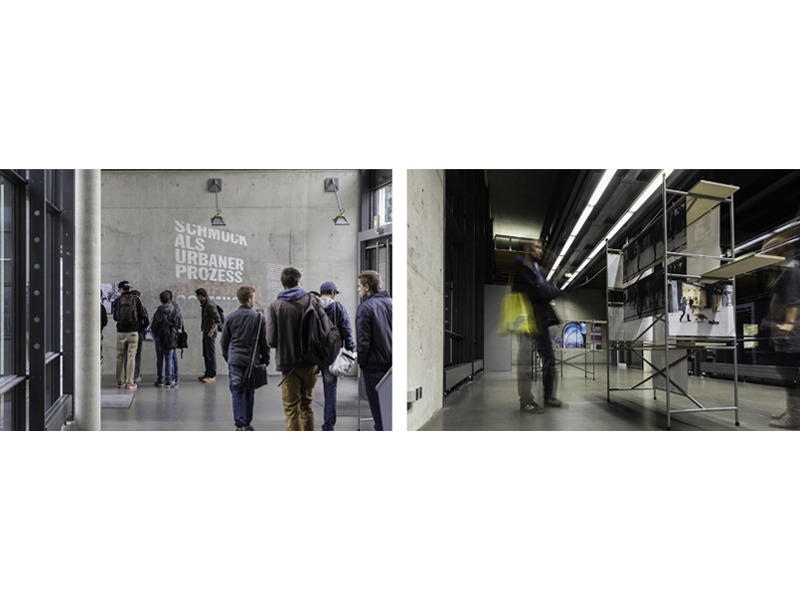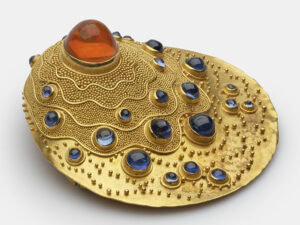Bilingual German / English.
ISBN 978 3 8030 0784 1
With texts and contributions by: Susanne Anna, Jacqui Chan, Willi Dorner, Karsten M. Drohsel, Elisabeth Holder, Barbara Maas, Yuka Oyama, Gabi Schillig, and Rennie K. Tang.

The metal department at the Hochchschule Düsseldorf (University of Applied Sciences in Düsseldorf, or HSD), led by Professor Elisabeth Holder and Professor Herman Hermsen, is well known for its product design orientation with an emphasis on exploring the tension between one-off and series, the hand made and the industrial. According to Karl Schollmayer, author of the seminal book Neuer Schmuck: Ornamentum Humanum (Pforzheim, 1974), Düsseldorf belongs to the historical first venues for art jewelry in Europe, where since the mid 1960s, Friedrich Becker, the father of kinetic jewelry, had established this current.
The metal department in Düsseldorf has not only built an international reputation in the field of jewelry art and design, but also has been known for its intelligent and well-crafted publications, like Pretty Sharp: Jewelry, Implements and Products, a book with works by students and staff (Arnoldsche, 2002). With the book Schmuck als Urbaner Prozess/Artistic Interventions in Urban Space, the department sets a new standard for jewelry publications. The book documents a research project that took place between 2012 and 2015 at the IRAA (Institute for Research in the Applied Arts, which is part of the HSD) in cooperation with the Stadtmuseum Düsseldorf. The project leaders and book editors are Professor Elisabeth Holder and Professor Gabi Schillig.
Elisabeth Holder has a background as a goldsmith at the HSD and at the Royal College of Art. She has widely exhibited her work and, as an academic, she investigates an expanded definition of jewelry design. Since 1988 she has been appointed professor of jewelry design in the design department of the HSD. Gabi Schillig studied architecture in Coburg, Germany, and conceptual design at the Städelschule in Frankfurt before founding her studio in Berlin. In her artistic practice and teaching she explores the relationship between space and body, textile materiality and interaction.

The research project started in 2012 out of the conversations between Holder, Schillig, and Dr. Susanne Anna, director of the Stadtmuseum Düsseldorf. The central thesis of the discussion was Holder’s notion of “jewelry as contextual art,” which she defines as “an action-based and processual act in the sense of adornment that is situational, and more flowing and transient than jewelry solidified in an object.”[1] In addition, the team advocates for a rather elastic meaning of the German word “Schmuck,” which refers not only to jewelry as artifact worn on the body, but also includes architectural façade, gravestone, flower, or Christmas tree decoration. From the beginning of the cooperation, it was clear that the topic “jewelry as urban process” had a great potential to be translated into an exciting exhibition. With this goal in mind, the team structured the project in four parts, represented in the book: students’ projects, symposium, exhibition, and documentation.
Experimenting
Under the guidance of Holder and Schillig, 94 students from the design department (mostly BA students from jewelry, visual communication, and master’s students from the degree program in applied art and design) took part in several modules distributed along four semesters, and developed not less than 61 proposals. In the last section of the book one can find the brief for each module: these included exercises to understand jewelry as context-specific action, or learning what a performative environment is in order to develop objects and situations of interaction.
The resulting objects, performative systems, installations, and interventions aimed to go beyond common definitions of jewelry, according to the statement given on the project’s website. And indeed, the project succeeds in engaging jewelry students to think beyond objects and daring to try other artistic formats that can also speak the language of jewelry. Even though the illustrated works are experiments and sketches, the book documents the students’ projects in an exemplary manner, and brings together an enormous amount of information. Each output is treated individually, and the book captures students’ statements and processes and uses several double pages in order to richly illustrate the works with many pictures that look like film sequences. Given the emphasis put on performative and situated work, the book would have benefitted from including a CD, or the website from featuring film and sound footage in order to document such actions.

Categorizing
After reviewing the outputs, the project leaders identified six thematic categories, which would not only classify the students’ work, but would also structure the areas of the exhibition, articulate the symposium’s program and title the different chapters of the book. These categories follow the formula “the city as … ”: inspiration, material, exploration, stage, occasion, and invitation.
The category “City as inspiration” includes design concepts that reacted to formal characteristics of the urban space, and took them as inspiration for the work. This section brings together projects that are mostly illustrations or miniaturizations of urban elements. “City as material” reunites projects that have explored the aesthetic potential of the objet trouvé, through discarded materials and rubbish. “City as exploration” mostly documents projects that have used performance as form of intervention in order to create situations that question the commonplace and create some friction in the familiar routines of the urban space. “City as stage” comprises site-specific productions that create interruptions in the expected flow of events on the street. “City as occasion” shows several actions of adornment that have chosen to address places with ambivalent positive and negative connotations. “City as invitation” brings together interventions that have actively involved passers-by as actors.

Spreading over 200 pages, these chapters constitute the core of the book. The location of information both vertically and horizontally on the pages requires the reader to sometimes turn the book 90° to the right. In this position, one can access a meta-level of content that provides the technical details of each project as well as its affiliation to over-arching keywords and fields of further discussion. It indicates, for example, which kind of artistic format (performance, artifact, intervention, installation) has been used and which kind of urban strategy has been developed (for example “redefining space,” or “pointing at the unnoticed”). This information appears only in German in the main text, but it can be found in both German and English in the appendix, thanks to an entertaining and very systematic table. This meta-level of information shows the great amount of work, care, and thoroughness that the authors have invested in analyzing each student’s project, contextualizing and cross-referencing them in order to create a discursive texture that connects all the proposals together.

Analyzing
Alongside the aforementioned sections, the reader is presented with six additional texts by the guest authors who were involved in the symposium, including Yuka Oyama and Jacqui Chan, whose work has been widely acclaimed as paradigmatic of jewelry’s engagement in participatory practices. In her text, “Schmuck as Urban Process in the Stadtmuseum”, Susanne Anna, director of the Stadtmuseum Düsseldorf, suggests that the museum sees itself as a platform for the design of urban processes. Its collections range from antiquity to present day, and she sees artifacts as forgers of citizenship and reminders of urban life. The essay “Random Inspiration. Methods of Walking,” by the urban planner and walking artist Karsten Michael Drossel, focuses on acts of walking as artistic practice in the urban space, tracing a genealogy that links Baudelaire’s flâneur, via Walter Benjamin, with the dérive exercises of the Internationale Situationniste. With “Jewelry, the Urban Milieu and Emergence,” New Zealand-based jewelry artist Jacqui Chan presents fragments of her PhD on the question of jewelry’s relation with the city through her participative projects in Melbourne and Christchurch. Urban designer Rennie K. Tang (Berlin), reports on her research project, which attempts to bridge the gap between human and urban scale, suggesting innovative approaches that could stand somewhere between urban design, landscape architecture, and dance.
The Viennese choreographer Willi Dorner describes his temporary choreographed interventions in the public space, where a group of dancers would create temporary sculptures, with their bodies folding and stacking up on doorways, stair landings, and filling unexpected in-between spaces. Yuka Oyama’s text, “Working in Public Space on Schmuck,” is an artist’s statement about the ritual of creating ornaments as a collective practice that is negotiated every time across private and public spheres. The Berlin-based jewelry artist reports on her most well-known projects, like Schmuck Quickies, Berlin Flowers, or Metamorphic Spirits. Last but not least, both editors have written articles providing their individual take on the subject. Schillig’s text, “Mediating Realities and Magnetizing Space,” explores collective bodies and collective spaces, multisensoriality, and aesthetic immersion from an art historical and media theory perspective, analyzing works of Brazilian artists from the Neo-Concrete Movement from the mid 1960’s. Holder’s “Actions of Adornment in Urban Contexts” discusses the action of adorning, which is summarized by a will to touch, surprise, and delight the individual caught in his/her isolation within the masses.[2] She analyzes some of the projects of the book to make her statements clearer.
Making Public
The symposium (October 4, 2014), which attracted around 200 participants, is documented through pictures of the presentations. This part of the book includes an article by Barbara Maas, the art historian who moderated the symposium. She offers a historical overview on “Artistic Strategies in the Network of Urban Reality,” from Richard Long’s A Line Made by Walking, from the early 1960s, to Mona Hatoum’s Road Works in the 1980s. She mentions actions by the choreographer Willi Dorner in the 2000s and community projects by Yuka Oyama. Maas also analyzes some of the students’ works. Hers is a valuable essay that contextualizes jewelry projects within the wider field of visual arts.

A further chapter is devoted to documenting the exhibition at the Stadtmuseum (November 2014–January 2015), with an introductory text by the curators in which they expose the challenges of setting up the show and also describe the parallel events surrounding it, like jewelry tours, jewelry incidents, public interactions, and a market. Holder calls the act of exhibiting “reflective staging.”[3] The exhibition design was inspired by the E2 modular system, a design classic developed by German Modernist architect Egon Eiermann consisting of a welded steel diagonal cross that can support several wooden panels to be used as tables or backgrounds, depending on the needs. The chapter also reports on the development of the graphic concept for the exhibition, designed by students of visual communication. This section is richly illustrated with exhibition views that reveal how the aesthetics of the display and of the book’s design were conceived as a coherent whole.
The book has an epilogue, with a conclusion by Holder and Schillig that points at the relationship between people, places, things, and actions as formal ingredients for spatial artistic investigations. The “actions of adornment”[4] presented in the book aim to raise awareness, change perceptions, amuse, and inspire, as much as encourage a questioning of the commonplace. Here is where the authors see the future potential of Schmuck as a form of contextual art with new applications. One could argue that if the project team had engaged with the urban context in a more critical manner, the potential of jewelry as “contextual art” would have increased. A purely phenomenological approach risks missing the aspects of conflict, emergency, struggle, or marginality that are also constitutive of the urban space.

The appendix is printed in vertical orientation and requires the reader to turn the book 90°. It gives a wide account on the structure of the courses, on the one hand those imparted by Professor Holder—including the abstracts of an MA thesis and a BA thesis—and on the other the courses conducted by Professor Schillig. There is a table with all projects listed, organized by the six thematic sections and offering a detailed overview with the above mentioned meta-level of information about the works. This is a very interesting and valuable part of the book, since at a single glance one can grasp which kind of discursive ground has been covered by the sum of the projects. The table classifies the projects not only by their authorship, title, artistic media, and location, but also by following analytic criteria: It asks, Which kind of relationship has been established? (Examples given include site – human; site – object; object – human; human – human.) Which kind of urban process has been set in motion? (Examples include “reveals a hidden beauty;” “inspires reflection;” “questions the norm.”) Which artistic strategies have been employed? (For example: “objects as magnets for participation;” “altering behavior of pedestrians;” “transforming by generating traces.”) This very last part of the book sums up its best qualities: Scholarly, inspiring, rigorous, and somehow excessive.
Schmuck als Urbaner Prozess sets a new standard in jewelry publications. It gives insight into the making of an academic project in the era of artistic research in higher education. The book is a valuable contribution to expand theoretical tools in order to document and analyze contemporary post-studio practices in jewelry, shifting the perspective from the narratives around the object toward observing processes and practices. A most welcome, not-to-be-missed publication.






